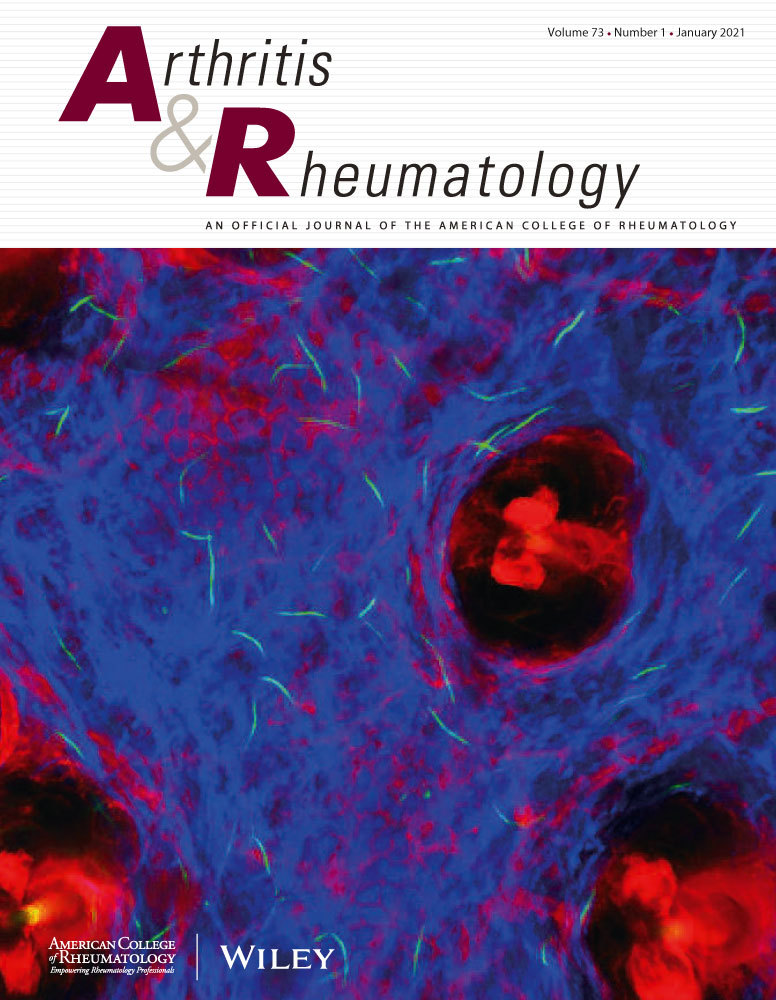羟氯喹治疗不完全性狼疮的随机、安慰剂对照试验。
IF 10.9
1区 医学
Q1 RHEUMATOLOGY
引用次数: 0
摘要
目的具有系统性红斑狼疮(SLE)特征但不符合分类标准的患者可被认定为不完全性狼疮(ILE)。这种情况包括发展为SLE的高风险个体。ILE的治疗可以减轻SLE的症状、严重程度和发病率。方法选择盐酸氯喹(HCQ)作为ILE干预剂进行随机双盲试验,以确定是否可以降低2012年SLICC标准定义的SLE特征的累积率。ILE定义为ANA阳性并伴有1-2个附加标准。15-49岁的患者符合条件。随机分组为1:1 HCQ与安慰剂。在24个月内每隔3个月进行一次评估。尽早达到SLICC分类要求退出。结果187例受试者被随机分为7个试验点。在筛选实验室数据完成后,排除了7例基线时符合SLE分类的患者,分析了180例患者:92例使用HCQ, 88例使用安慰剂。平均年龄33岁,女性占91.1%,白人占74.4%。SLE分型24例(13.3%);另有24个国家制定了附加标准,但不符合分类标准。两组患者获得SLICC标准和进展为SLE的比率相似(P=0.72和P=0.98)。SLE的发展与新的恶性皮疹、口腔溃疡、关节压痛或胸膜炎相关(P<0.04)。虽然SMILE没有显示HCQ对ILE进展的影响,但结果为ILE人群的SLE风险提供了见解。随着生物标志物的发展,设计有针对性的预防策略应该是可行的。本文章由计算机程序翻译,如有差异,请以英文原文为准。
A randomized, placebo-controlled trial of hydroxychloroquine in incomplete lupus.
OBJECTIVES
Patients with features of systemic lupus erythematosus (SLE) who do not fulfill classification criteria can be designated as incomplete lupus (ILE). This condition includes individuals with a high risk of progression to SLE. Treatment of ILE may reduce symptoms, severity and incidence of SLE.
METHODS
Hydroxychloroquine (HCQ) was chosen as an ILE intervention for a randomized, double-blind trial to determine whether rate of accumulation of SLE features defined by the 2012 SLICC criteria could be reduced. ILE was defined as ANA positivity with 1-2 additional criteria. Patients 15-49 years old were eligible. Randomization was 1:1 HCQ to placebo. Evaluations were at 3-month intervals over 24 months. Meeting SLICC classification sooner required exit.
RESULTS
Participants (n=187) were randomized at 7 sites. After excluding 7 patients who met SLE classification at baseline when screening laboratory data were completed, 180 patients were analyzed: 92 on HCQ and 88 on placebo. The mean age was 33 years, 91.1% were female and 74.4% were white. SLE classification developed in 24 (13.3%); another 24 developed additional criteria but did not meet classification. The rates of acquisition of SLICC criteria and progression to SLE were similar in the two groups (P=0.72 and P=0.98, respectively). Development of SLE was associated with new malar rash, oral ulcers, joint tenderness or pleurisy (P<0.04).
CONCLUSION
While SMILE did not show effects of HCQ on ILE progression, the results offer insights into SLE risk in the ILE population. With development of biomarkers, designing targeted prevention strategies should be feasible.
求助全文
通过发布文献求助,成功后即可免费获取论文全文。
去求助
来源期刊

Arthritis & Rheumatology
RHEUMATOLOGY-
CiteScore
20.90
自引率
3.00%
发文量
371
期刊介绍:
Arthritis & Rheumatology is the official journal of the American College of Rheumatology and focuses on the natural history, pathophysiology, treatment, and outcome of rheumatic diseases. It is a peer-reviewed publication that aims to provide the highest quality basic and clinical research in this field. The journal covers a wide range of investigative areas and also includes review articles, editorials, and educational material for researchers and clinicians. Being recognized as a leading research journal in rheumatology, Arthritis & Rheumatology serves the global community of rheumatology investigators and clinicians.
 求助内容:
求助内容: 应助结果提醒方式:
应助结果提醒方式:


